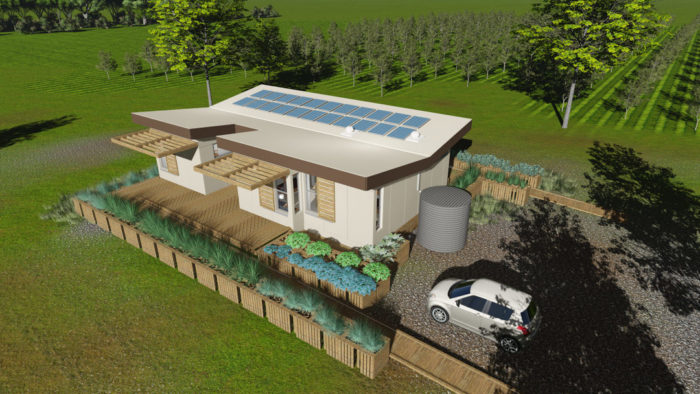Image Credit: Department of Energy Solar Decathlon via Flickr Creative Commons license
Image Credit: Department of Energy Solar Decathlon via Flickr Creative Commons license Flexible interior spaces are meant to encourage groups of people to gather but also provide a private area. The house is designed so workers can clean up outdoors before coming inside.
A design team at the University of California, Davis, has focused its attention on the often unmet needs of farm laborers for its entry in this year’s Solar Decathlon.
It’s the first time the school has participated in the competition sponsored by the U.S. Department of Energy. The U.C. Davis entry, what its designers are calling the Aggie Sol home, is one of 16 university solar-powered houses that will be on display in Irvine, California, beginning on October 8.
The house is specifically designed for farm workers on the West Coast, the team’s website says, and is intended as a model for affordable housing that can “replace the inefficient grid-dependent houses that currently dominate the market.”
The U.C. Davis team hoped to develop a template for housing that would benefit a group of people who often make do with substandard housing.
“In the United States, over one million people are working as farm laborers, and with 12% of all U.S. agricultural exports coming out of California, it is clear that many of these farm workers are here in our own backyard,” the team’s website says. “These workers are often living in deplorable conditions, with no plumbing, no temperature control, and extreme overcrowding due to their inability to afford anything better.”
Features fit for the farm
Farm workers get dirty, and they’re likely to run into pesticides or herbicides in the course of a day — factors the student designers took into account. A second entryway to the home was designed as a cleansing zone where workers can shed shoes and clothing, use a shower and pull clean clothing from double-sided lockers before going inside.
The design team originally planned to use straw-bale construction (some online articles still include this description), but later the plans were changed in favor of more conventional 2×6 construction and fiberglass batt insulation, said Claire DeCamp, a university representative on the project.
Students are building the house on two refurbished house trailers on campus, and the intent of the design, DeCamp said, is that the components could be made as modular units in a factory and trucked to their destination for assembly.
Other features of the house, taken from the UCDavis team website:
- Materials that contribute to high indoor air quality, such as air-purifying plants and linoleum flooring that doesn’t off-gas volatile organic compounds.
- Flexible indoor spaces that encourage groups to gather but also a master bedroom that provides some privacy.
- Radiant heating and cooling system using a rainwater reservoir. At night, water from the reservoir is sprayed into the air through a rooftop sprinkler. The chilled water is then filtered and pumped through the radiant slab during the day to cool the house. When needed, the same tubing can distribute heated water.
- A heat exchanger to pull energy from domestic gray water to preheat potable hot water.
- Solar tubes for indoor lighting
One of the group’s primary goals was to design a net-zero home that both public and private housing providers could afford, the website says. There’s more about the project in this YouTube video.
Weekly Newsletter
Get building science and energy efficiency advice, plus special offers, in your inbox.












0 Comments
Log in or create an account to post a comment.
Sign up Log in